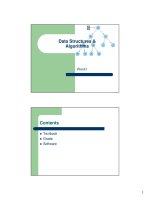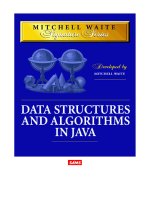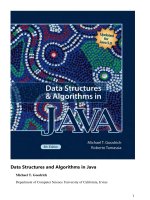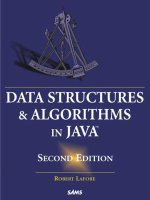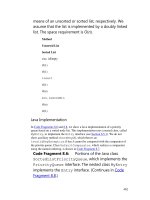Data Structures & Algorithms in Java doc
Bạn đang xem bản rút gọn của tài liệu. Xem và tải ngay bản đầy đủ của tài liệu tại đây (4.07 MB, 801 trang )
800 East 96th Street, Indianapolis, Indiana 46240
Data Structures
& Algorithms
in Java
Second Edition
Robert Lafore
00 0672324539 fm 8/28/03 9:35 AM Page i
Data Structures and Algorithms in Java,
Second Edition
Copyright © 2003 by Sams Publishing
All rights reserved. No part of this book shall be reproduced, stored
in a retrieval system, or transmitted by any means, electronic,
mechanical, photocopying, recording, or otherwise, without
written permission from the publisher. No patent liability is
assumed with respect to the use of the information contained
herein. Although every precaution has been taken in the prepara-
tion of this book, the publisher and author assume no responsibil-
ity for errors or omissions. Nor is any liability assumed for damages
resulting from the use of the information contained herein.
International Standard Book Number: 0-672-32453-9
Library of Congress Catalog Card Number: 2002106907
Printed in the United States of America
First Printing: December 2002
05 04 03 4 3
Trademarks
All terms mentioned in this book that are known to be trademarks
or service marks have been appropriately capitalized. Sams
Publishing cannot attest to the accuracy of this information. Use of
a term in this book should not be regarded as affecting the validity
of any trademark or service mark.
Warning and Disclaimer
Every effort has been made to make this book as complete and as
accurate as possible, but no warranty or fitness is implied. The
information provided is on an “as is” basis. The author and the
publisher shall have neither liability nor responsibility to any
person or entity with respect to any loss or damages arising from
the information contained in this book.
Bulk Sales
Sams Publishing offers excellent discounts on this book when
ordered in quantity for bulk purchases or special sales. For more
information, please contact
U.S. Corporate and Government Sales
1-800-382-3419
For sales outside of the U.S., please contact
International Sales
1-317-428-3341
Executive Editor
Michael Stephens
Acquisitions Editor
Carol Ackerman
Development Editor
Songlin Qiu
Managing Editor
Charlotte Clapp
Project Editor
Matt Purcell
Copy Editor
Chuck Hutchinson
Indexer
Johnna Dinse
Proofreader
Cindy Long
Technical Editor
Mike Kopack
Team Coordinator
Lynne Williams
Multimedia Developer
Dan Scherf
Interior Designer
Gary Adair
Cover Designer
Alan Clements
Production
Plan-it Publishing
00 0672324539 fm 8/28/03 9:35 AM Page ii
Contents at a Glance
Introduction 1
1 Overview
9
2 Arrays
33
3 Simple Sorting
77
4 Stacks and Queues
115
5 Linked Lists
179
6 Recursion
251
7 Advanced Sorting
315
8 Binary Trees
365
9 Red-Black Trees
429
10 2-3-4 Trees and External Storage
463
11 Hash Tables
519
12 Heaps
579
13 Graphs
615
14 Weighted Graphs
669
15 When to Use What
717
Appendixes
A Running the Workshop Applets and Example Programs
729
B Further Reading
735
C Answers to Questions
739
Index
749
00 0672324539 fm 10/10/02 9:13 AM Page iii
Table of Contents
Introduction 1
What’s New in the Second Edition 1
Additional Topics 1
End-of-Chapter Questions 2
Experiments 2
Programming Projects 2
What This Book Is About 2
What’s Different About This Book 3
Easy to Understand 3
Workshop Applets 4
Java Example Code 5
Who This Book Is For 5
What You Need to Know Before You Read This Book 5
The Software You Need to Use This Book 6
How This Book Is Organized 6
Enjoy Yourself! 8
1 Overview 9
What Are Data Structures and Algorithms Good For? 9
Real-World Data Storage 10
Programmer’s Tools 11
Real-World Modeling 11
Overview of Data Structures 11
Overview of Algorithms 12
Some Definitions 13
Database 13
Record 13
Field 13
Key 14
Object-Oriented Programming 14
Problems with Procedural Languages 14
Objects in a Nutshell 15
A Runnable Object-Oriented Program 18
Inheritance and Polymorphism 21
Software Engineering 21
00 0672324539 fm 10/10/02 9:13 AM Page iv
Java for C++ Programmers 22
No Pointers 22
Overloaded Operators 25
Primitive Variable Types 25
Input/Output 26
Java Library Data Structures 29
Summary 30
Questions 30
2Arrays 33
The Array Workshop Applet 33
Insertion 35
Searching 36
Deletion 36
The Duplicates Issue 37
Not Too Swift 39
The Basics of Arrays in Java 39
Creating an Array 40
Accessing Array Elements 40
Initialization 41
An Array Example 41
Dividing a Program into Classes 44
Classes
LowArray and LowArrayApp 46
Class Interfaces 46
Not So Convenient 47
Who’s Responsible for What? 48
The
highArray.java Example 48
The User’s Life Made Easier 52
Abstraction 52
The Ordered Workshop Applet 52
Linear Search 53
Binary Search 54
Java Code for an Ordered Array 56
Binary Search with the
find() Method 56
The
OrdArray Class 58
Advantages of Ordered Arrays 61
Logarithms 62
The Equation 63
The Opposite of Raising Two to a Power 64
00 0672324539 fm 10/10/02 9:13 AM Page v
Storing Objects 64
The
Person Class 65
The
classDataArray.java Program 65
Big O Notation 70
Insertion in an Unordered Array: Constant 70
Linear Search: Proportional to N 70
Binary Search: Proportional to log(N) 71
Don’t Need the Constant 71
Why Not Use Arrays for Everything? 72
Summary 73
Questions 74
Experiments 75
Programming Projects 76
3Simple Sorting 77
How Would You Do It? 78
Bubble Sort 79
Bubble Sort on the Baseball Players 79
The BubbleSort Workshop Applet 81
Java Code for a Bubble Sort 85
Invariants 88
Efficiency of the Bubble Sort 88
Selection Sort 89
Selection Sort on the Baseball Players 89
The SelectSort Workshop Applet 90
Java Code for Selection Sort 92
Invariant 95
Efficiency of the Selection Sort 95
Insertion Sort 95
Insertion Sort on the Baseball Players 95
The InsertSort Workshop Applet 97
Java Code for Insertion Sort 99
Invariants in the Insertion Sort 103
Efficiency of the Insertion Sort 103
Sorting Objects 103
Java Code for Sorting Objects 104
Lexicographical Comparisons 107
Stability 107
Comparing the Simple Sorts 108
Summary 108
Data Structures & Algorithms in Java, Second Editionvi
00 0672324539 fm 10/10/02 9:13 AM Page vi
Questions 109
Experiments 111
Programming Projects 112
4 Stacks and Queues 115
A Different Kind of Structure 115
Programmer’s Tools 115
Restricted Access 116
More Abstract 116
Stacks 116
The Postal Analogy 117
The Stack Workshop Applet 118
Java Code for a Stack 120
Stack Example 1: Reversing a Word 124
Stack Example 2: Delimiter Matching 127
Efficiency of Stacks 132
Queues 132
The Queue Workshop Applet 133
A Circular Queue 136
Java Code for a Queue 137
Efficiency of Queues 142
Deques 143
Priority Queues 143
The PriorityQ Workshop Applet 144
Java Code for a Priority Queue 147
Efficiency of Priority Queues 149
Parsing Arithmetic Expressions 149
Postfix Notation 150
Translating Infix to Postfix 151
Evaluating Postfix Expressions 167
Summary 173
Questions 174
Experiments 176
Programming Projects 176
5Linked Lists 179
Links 179
References and Basic Types 180
Relationship, Not Position 182
Contents vii
00 0672324539 fm 10/10/02 9:13 AM Page vii
Data Structures & Algorithms in Java, Second Editionviii
The LinkList Workshop Applet 183
The Insert Button 183
The Find Button 184
The Delete Button 184
A Simple Linked List 185
The
Link Class 185
The
LinkList Class 186
The
insertFirst() Method 187
The
deleteFirst() Method 188
The
displayList() Method 189
The
linkList.java Program 190
Finding and Deleting Specified Links 193
The
find() Method 196
The
delete() Method 196
Other Methods 197
Double-Ended Lists 198
Linked-List Efficiency 202
Abstract Data Types 202
A Stack Implemented by a Linked List 203
A Queue Implemented by a Linked List 206
Data Types and Abstraction 210
ADT Lists 211
ADTs as a Design Tool 212
Sorted Lists 212
Java Code to Insert an Item in a Sorted List 213
The
sortedList.java Program 215
Efficiency of Sorted Linked Lists 218
List Insertion Sort 218
Doubly Linked Lists 221
Traversal 222
Insertion 223
Deletion 225
The
doublyLinked.java Program 226
Doubly Linked List as Basis for Deques 231
Iterators 231
A Reference in the List Itself? 232
An Iterator Class 232
Additional Iterator Features 233
Iterator Methods 234
The
interIterator.java Program 235
00 0672324539 fm 10/10/02 9:13 AM Page viii
Contents ix
Where Does the Iterator Point? 242
The
atEnd() Method 242
Iterative Operations 243
Other Methods 244
Summary 244
Questions 245
Experiments 247
Programming Projects 247
6 Recursion 251
Triangular Numbers 251
Finding the
nth Term Using a Loop 252
Finding the
nth Term Using Recursion 253
The
triangle.java Program 255
What’s Really Happening? 257
Characteristics of Recursive Methods 259
Is Recursion Efficient? 259
Mathematical Induction 259
Factorials 260
Anagrams 262
A Recursive Binary Search 268
Recursion Replaces the Loop 268
Divide-and-Conquer Algorithms 272
The Towers of Hanoi 273
The Towers Workshop Applet 274
Moving Subtrees 275
The Recursive Algorithm 276
The
towers.java Program 277
mergesort 279
Merging Two Sorted Arrays 280
Sorting by Merging 283
The MergeSort Workshop Applet 285
The
mergeSort.java Program 287
Efficiency of the mergesort 291
Eliminating Recursion 294
Recursion and Stacks 294
Simulating a Recursive Method 294
What Does This Prove? 301
Some Interesting Recursive Applications 303
Raising a Number to a Power 303
00 0672324539 fm 10/10/02 9:13 AM Page ix
Data Structures & Algorithms in Java, Second Editionx
The Knapsack Problem 305
Combinations: Picking a Team 306
Summary 308
Questions 310
Experiments 312
Programming Projects 312
7Advanced Sorting 315
Shellsort 315
Insertion Sort: Too Many Copies 316
N-Sorting 316
Diminishing Gaps 317
The Shellsort Workshop Applet 319
Java Code for the Shellsort 321
Other Interval Sequences 324
Efficiency of the Shellsort 324
Partitioning 325
The Partition Workshop Applet 325
The
partition.java Program 327
The Partition Algorithm 330
Efficiency of the Partition Algorithm 332
Quicksort 333
The Quicksort Algorithm 333
Choosing a Pivot Value 335
The QuickSort1 Workshop Applet 340
Degenerates to O(N2) Performance 344
Median-of-Three Partitioning 345
Handling Small Partitions 350
Removing Recursion 354
Efficiency of Quicksort 355
Radix Sort 357
Algorithm for the Radix Sort 358
Designing a Program 358
Efficiency of the Radix Sort 359
Summary 359
Questions 361
Experiments 363
Programming Projects 363
00 0672324539 fm 10/10/02 9:13 AM Page x
Contents xi
8Binary Trees 365
Why Use Binary Trees? 365
Slow Insertion in an Ordered Array 365
Slow Searching in a Linked List 366
Trees to the Rescue 366
What Is a Tree? 366
Tree Terminology 367
Path 368
Root 368
Parent 369
Child 369
Leaf 369
Subtree 369
Visiting 369
Traversing 369
Levels 369
Keys 369
Binary Trees 370
An Analogy 370
How Do Binary Search Trees Work? 371
The Binary Tree Workshop Applet 371
Representing the Tree in Java Code 373
Finding a Node 376
Using the Workshop Applet to Find a Node 376
Java Code for Finding a Node 377
Tree Efficiency 378
Inserting a Node 378
Using the Workshop Applet to Insert a Node 379
Java Code for Inserting a Node 379
Traversing the Tree 381
Inorder Traversal 381
Java Code for Traversing 382
Traversing a Three-Node Tree 382
Traversing with the Workshop Applet 384
Preorder and Postorder Traversals 385
Finding Maximum and Minimum Values 388
Deleting a Node 389
Case 1: The Node to Be Deleted Has No Children 389
Case 2: The Node to Be Deleted Has One Child 391
Case 3: The Node to Be Deleted Has Two Children 393
00 0672324539 fm 10/10/02 9:13 AM Page xi
Data Structures & Algorithms in Java, Second Editionxii
The Efficiency of Binary Trees 401
Trees Represented as Arrays 403
Duplicate Keys 404
The Complete
tree.java Program 405
The Huffman Code 415
Character Codes 415
Decoding with the Huffman Tree 417
Creating the Huffman Tree 418
Coding the Message 420
Creating the Huffman Code 421
Summary 422
Questions 423
Experiments 425
Programming Projects 425
9 Red-Black Trees 429
Our Approach to the Discussion 429
Conceptual 430
Top-Down Insertion 430
Balanced and Unbalanced Trees 430
Degenerates to O(N) 431
Balance to the Rescue 432
Red-Black Tree Characteristics 432
Fixing Rule Violations 434
Using the RBTree Workshop Applet 434
Clicking on a Node 435
The Start Button 435
The Ins Button 435
The Del Button 436
The Flip Button 436
The RoL Button 436
The RoR Button 436
The R/B Button 436
Text Messages 437
Where’s the Find Button? 437
Experimenting with the Workshop Applet 437
Experiment 1: Inserting Two Red Nodes 437
Experiment 2: Rotations 438
Experiment 3: Color Flips 439
00 0672324539 fm 10/10/02 9:13 AM Page xii
Experiment 4: An Unbalanced Tree 439
More Experiments 440
The Red-Black Rules and Balanced Trees 440
Null Children 441
Rotations 441
Simple Rotations 442
The Weird Crossover Node 442
Subtrees on the Move 444
Human Beings Versus Computers 445
Inserting a New Node 445
Preview of the Insertion Process 446
Color Flips on the Way Down 446
Rotations After the Node Is Inserted 448
Rotations on the Way Down 454
Deletion 457
The Efficiency of Red-Black Trees 457
Red-Black Tree Implementation 458
Other Balanced Trees 458
Summary 459
Questions 460
Experiments 462
10 2-3-4 Trees and External Storage 463
Introduction to 2-3-4 Trees 463
What’s in a Name? 464
2-3-4 Tree Organization 465
Searching a 2-3-4 Tree 466
Insertion 466
Node Splits 467
Splitting the Root 468
Splitting on the Way Down 469
The Tree234 Workshop Applet 470
The Fill Button 471
The Find Button 471
The Ins Button 472
The Zoom Button 472
Viewing Different Nodes 473
Experiments 474
Java Code for a 2-3-4 Tree 475
Contents xiii
00 0672324539 fm 10/10/02 9:13 AM Page xiii
The DataItem Class 475
The
Node Class 475
The
Tree234 Class 476
The
Tree234App Class 477
The Complete
tree234.java Program 478
2-3-4 Trees and Red-Black Trees 486
Transformation from 2-3-4 to Red-Black 486
Operational Equivalence 488
Efficiency of 2-3-4 Trees 491
Speed 491
Storage Requirements 491
2-3 Trees 492
Node Splits 492
Implementation 494
External Storage 496
Accessing External Data 496
Sequential Ordering 499
B-Trees 500
Indexing 506
Complex Search Criteria 509
Sorting External Files 509
Summary 513
Questions 514
Experiments 516
Programming Projects 516
11 Hash Tables 519
Introduction to Hashing 520
Employee Numbers as Keys 520
A Dictionary 521
Hashing 525
Collisions 527
Open Addressing 528
Linear Probing 528
Java Code for a Linear Probe Hash Table 533
Quadratic Probing 542
Double Hashing 544
Separate Chaining 552
The HashChain Workshop Applet 552
Java Code for Separate Chaining 555
Data Structures & Algorithms in Java, Second Editionxiv
00 0672324539 fm 10/10/02 9:13 AM Page xiv
Hash Functions 561
Quick Computation 561
Random Keys 562
Non-Random Keys 562
Hashing Strings 563
Folding 566
Hashing Efficiency 566
Open Addressing 566
Separate Chaining 568
Open Addressing Versus Separate Chaining 570
Hashing and External Storage 571
Table of File Pointers 571
Non-Full Blocks 571
Full Blocks 572
Summary 573
Questions 574
Experiments 576
Programming Projects 577
12 Heaps 579
Introduction to Heaps 580
Priority Queues, Heaps, and ADTs 581
Weakly Ordered 582
Removal 583
Insertion 585
Not Really Swapped 586
The Heap Workshop Applet 587
The Fill Button 587
The Change Button 588
The Remove Button 588
The Insert Button 588
Java Code for Heaps 588
Insertion 589
Removal 590
Key Change 591
The Array Size 592
The
heap.java Program 592
Expanding the Heap Array 599
Efficiency of Heap Operations 599
Contents xv
00 0672324539 fm 10/10/02 9:13 AM Page xv
A Tree-based Heap 600
Heapsort 601
Trickling Down in Place 602
Using the Same Array 604
The
heapSort.java Program 605
The Efficiency of Heapsort 610
Summary 610
Questions 611
Experiments 612
Programming Projects 612
13 Graphs 615
Introduction to Graphs 615
Definitions 616
Historical Note 618
Representing a Graph in a Program 619
Adding Vertices and Edges to a Graph 622
The
Graph Class 622
Searches 623
Depth-First Search 625
Breadth-First Search 636
Minimum Spanning Trees 643
GraphN Workshop Applet 644
Java Code for the Minimum Spanning Tree 644
The
mst.java Program 645
Topological Sorting with Directed Graphs 649
An Example: Course Prerequisites 649
Directed Graphs 650
Topological Sorting 651
The GraphD Workshop Applet 652
Cycles and Trees 653
Java Code 654
Connectivity in Directed Graphs 661
The Connectivity Table 662
Warshall’s Algorithm 662
Implementation of Warshall’s Algorithm 664
Summary 665
Questions 665
Experiments 667
Programming Projects 667
Data Structures & Algorithms in Java, Second Editionxvi
00 0672324539 fm 10/10/02 9:13 AM Page xvi
14 Weighted Graphs 669
Minimum Spanning Tree with Weighted Graphs 669
An Example: Cable TV in the Jungle 670
The GraphW Workshop Applet 670
Send Out the Surveyors 672
Creating the Algorithm 676
Java Code 678
The
mstw.java Program 681
The Shortest-Path Problem 687
The Railroad Line 687
Dijkstra’s Algorithm 689
Agents and Train Rides 689
Using the GraphDW Workshop Applet 694
Java Code 698
The
path.java Program 703
The All-Pairs Shortest-Path Problem 708
Efficiency 710
Intractable Problems 710
The Knight’s Tour 711
The Traveling Salesman Problem 711
Hamiltonian Cycles 712
Summary 713
Questions 713
Experiments 715
Programming Projects 715
15 When to Use What 717
General-Purpose Data Structures 717
Speed and Algorithms 718
Libraries 719
Arrays 720
Linked Lists 720
Binary Search Trees 720
Balanced Trees 721
Hash Tables 721
Comparing the General-Purpose Storage Structures 722
Special-Purpose Data Structures 722
Stack 723
Queue 723
Contents xvii
00 0672324539 fm 10/10/02 9:13 AM Page xvii
Priority Queue 723
Comparison of Special-Purpose Structures 724
Sorting 724
Graphs 725
External Storage 725
Sequential Storage 726
Indexed Files 726
B-trees 726
Hashing 727
Virtual Memory 727
Onward 728
Appendixes
A Running the Workshop Applets and Example Programs 729
The Workshop Applets 729
The Example Programs 730
The Sun Microsystem’s Software Development Kit 730
Command-line Programs 731
Setting the Path 731
Viewing the Workshop Applets 731
Operating the Workshop Applets 732
Running the Example Programs 732
Compiling the Example Programs 733
Editing the Source Code 733
Terminating the Example Programs 733
Multiple Class Files 733
Other Development Systems 734
B Further Reading 735
Data Structures and Algorithms 735
Object-Oriented Programming Languages 736
Object-Oriented Design (OOD) and Software Engineering 736
C Answers to Questions 739
Chapter 1, Overview 739
Answers to Questions 739
Chapter 2, Arrays 739
Answers to Questions 739
Data Structures & Algorithms in Java, Second Editionxviii
00 0672324539 fm 10/10/02 9:13 AM Page xviii
Chapter 3, Simple Sorting 740
Answers to Questions 740
Chapter 4, Stacks and Queues 741
Answers to Questions 741
Chapter 5, Linked Lists 741
Answers to Questions 741
Chapter 6, Recursion 742
Answers to Questions 742
Chapter 7, Advanced Sorting 743
Answers to Questions 743
Chapter 8, Binary Trees 743
Answers to Questions 743
Chapter 9, Red-Black Trees 744
Answers to Questions 744
Chapter 10, 2-3-4 Trees and External Storage 745
Answers to Questions 745
Chapter 11, Hash Tables 745
Answers to Questions 745
Chapter 12, Heaps 746
Answers to Questions 746
Chapter 13, Graphs 746
Answers to Questions 746
Chapter 14, Weighted Graphs 747
Answers to Questions 747
Contents xix
00 0672324539 fm 10/10/02 9:13 AM Page xix
About the Author
Robert Lafore has degrees in Electrical Engineering and
Mathematics, has worked as a systems analyst for the Lawrence
Berkeley Laboratory, founded his own software company, and is
a best-selling writer in the field of computer programming.
Some of his current titles are C++ Interactive Course and Object-
Oriented Programming in C++. Earlier best-selling titles include
Assembly Language Primer for the IBM PC and XT and (back at the
beginning of the computer revolution) Soul of CP/M.
00 0672324539 fm 10/10/02 3:17 PM Page xx
Dedication
This book is dedicated to my readers, who have rewarded me
over the years not only by buying my books, but with helpful
suggestions and kind words. Thanks to you all.
00 0672324539 fm 10/10/02 9:13 AM Page xxi
Acknowledgments to the First Edition
My gratitude for the following people (and many others) cannot be fully expressed
in this short acknowledgment. As always, Mitch Waite had the Java thing figured out
before anyone else. He also let me bounce the applets off him until they did the job,
and extracted the overall form of the project from a miasma of speculation. My
editor, Kurt Stephan, found great reviewers, made sure everyone was on the same
page, kept the ball rolling, and gently but firmly ensured that I did what I was
supposed to do. Harry Henderson provided a skilled appraisal of the first draft, along
with many valuable suggestions. Richard S. Wright, Jr., as technical editor, corrected
numerous problems with his keen eye for detail. Jaime Niño, Ph.D., of the University
of New Orleans, attempted to save me from myself and occasionally succeeded, but
should bear no responsibility for my approach or coding details. Susan Walton has
been a staunch and much-appreciated supporter in helping to convey the essence of
the project to the non-technical. Carmela Carvajal was invaluable in extending our
contacts with the academic world. Dan Scherf not only put the CD-ROM together,
but was tireless in keeping me up to date on rapidly evolving software changes.
Finally, Cecile Kaufman ably shepherded the book through its transition from the
editing to the production process.
Acknowledgments to the Second Edition
My thanks to the following people at Sams Publishing for their competence, effort,
and patience in the development of this second edition. Acquisitions Editor Carol
Ackerman and Development Editor Songlin Qiu ably guided this edition through the
complex production process. Project Editor Matt Purcell corrected a semi-infinite
number of grammatical errors and made sure everything made sense. Tech Editor
Mike Kopak reviewed the programs and saved me from several problems. Last but
not least, Dan Scherf, an old friend from a previous era, provides skilled manage-
ment of my code and applets on the Sams Web site.
00 0672324539 fm 10/10/02 9:13 AM Page xxii
We Want to Hear from You!
As the reader of this book, you are our most important critic and commentator. We
value your opinion and want to know what we’re doing right, what we could do
better, what areas you’d like to see us publish in, and any other words of wisdom
you’re willing to pass our way.
As an executive editor for Sams Publishing, I welcome your comments. You can
email or write me directly to let me know what you did or didn’t like about this
book—as well as what we can do to make our books better.
Please note that I cannot help you with technical problems related to the topic of
this book. We do have a User Services group, however, where I will forward specific
technical questions related to the book.
When you write, please be sure to include this book’s title and author as well as your
name, email address, and phone number. I will carefully review your comments and
share them with the author and editors who worked on the book.
Email:
Mail: Michael Stephens
Executive Editor
Sams Publishing
800 East 96th Street
Indianapolis, IN 46240 USA
For more information about this book or another Sams Publishing title, visit our
Web site at
www.samspublishing.com
. Type the ISBN (excluding hyphens) or the title of
a book in the Search field to find the page you’re looking for.
00 0672324539 fm 8/28/03 9:35 AM Page xxiii
00 0672324539 fm 10/10/02 9:13 AM Page xxiv
